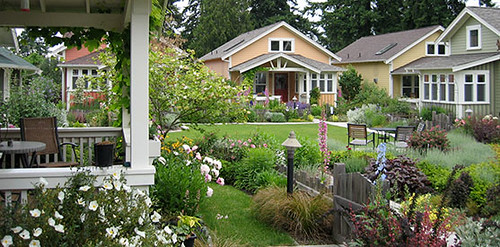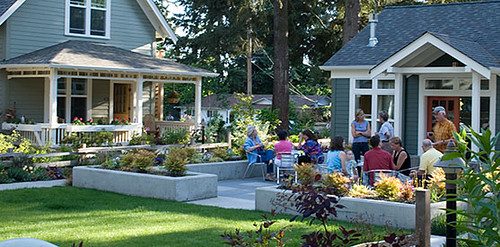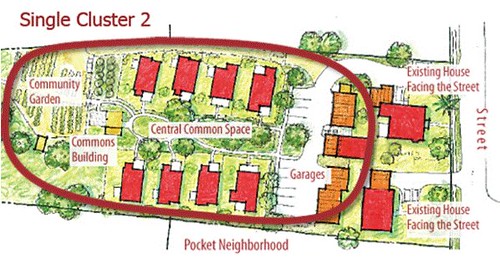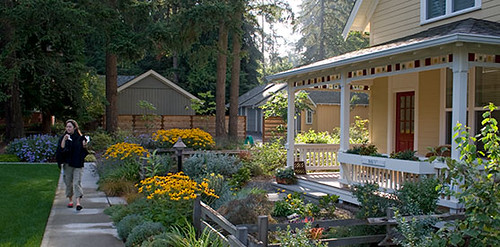Smaller, more sustainable living in neighborhoods that fit in

Posted January 3, 2012 at 1:28PM
When talking about reducing the footprint of our living patterns on the landscape and the earth’s limited resources, I always stress that this does not necessarily mean high-rises or even multi-family living at all. Those can be perfectly accessible pathways to sustainability for people who prefer them, but one can also have sustainably designed neighborhoods of single-family homes on moderately sized lots. The lots can be even smaller without sacrificing access to the outdoors if ample shared green space is integrated into the setting. Ultimately, more sustainable living patterns need to be about a diversity of choices within a community, rather than the ghettoes of identically sized and styled housing products typically offered during the recent heyday of sprawl.
For over a decade now, these beliefs have drawn me to the work of architect Ross Chapin, who has pioneered smaller-scaled home designs placed in beautiful community settings. He and I have never met, but my co-authors and I profiled his Third Street Cottages in Langley, Washington, in our book Solving Sprawl, and I featured the small infill development again in a 2008 article. I use images of the Third Street project often in my speaking engagements, because they are not only functional but also amazingly photogenic.
Third Street Cottages placed eight small homes around a shared common green, on about two-thirds of an acre in a walkable small town setting. To my eye, they look fantastic. To be sure, the small structures aren’t ideally sized for a large family, 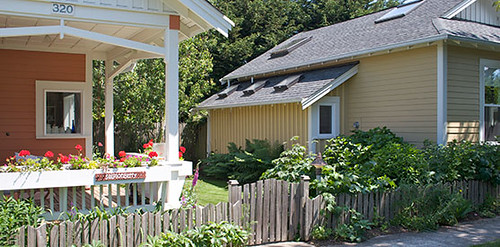 but their scale works for a significant part of the housing market, and the concept – a compact footprint around shared common space – can be and has been applied to groupings of larger homes that still conserve land and resources while increasing walkability.
but their scale works for a significant part of the housing market, and the concept – a compact footprint around shared common space – can be and has been applied to groupings of larger homes that still conserve land and resources while increasing walkability.
Chapin calls the concept “pocket neighborhoods,” and he is currently marketing a book of the same name, subtitled “Creating Small-Scale Community in a Large-Scale World.” I haven’t yet seen the book, but I’ve seen its outline and am familiar with many of the projects and approaches it describes. I have also spent a great deal of enjoyable time perusing the accompanying website.
The press release describes the central idea this way:
“Why pocket neighborhoods? Why now? There has been a monumental shift in how Americans are thinking about most everything; one increasingly evident being the way people are reimagining how they live in their homes and in their communities. The American Dream of owning a single-family home with a garage seems to be fading fast. Demographics and family structures have changed significantly and we are living in a larger scale world than our grandparents – a world with vastly more stresses and pressures.
“Pocket neighborhoods, best defined as clusters of homes gathered around a landscaped common area, are springing up all over the country. The people who live in these most sought-after communities know they share something extraordinarily valuable: a model of community that provides a missing link. They have their cherished privacy, but with something more: they get to know each other in a meaningful way, and are able to offer one another the kind of support system that family members across town, across state or across country cannot.”
Chapin stresses the community-building quality of the shared common space, especially for children who can mingle in a traffic-free outdoor environment.
This is a great idea, but not a new one. The idea of smaller lots coupled with shared commons can be seen in historic New England towns, more recent new urbanist developments and, indeed, in settlements going back to antiquity. It is the abandonment of that tried-and-true formula that is relatively new.
There are a number of things that I like about Chapin’s brand of smart-growth gospel. It does indeed allow efficient use of space and resources, which when practiced at scale also produces a secondary benefit of reducing and shortening car trips. Not insignificantly, Chapin's projects are pursued with great design and attention to beauty, in harmony with host communities; only the hardest of hard-core advocates (I do know a few, but not enough to make a difference) is going to sign up for sustainability that’s ugly.
But, perhaps most important, it is a strategy that can be implemented incrementally on smaller pieces of land. In my world, people are always looking for the Huge Idea to produce Big Change. But that’s not the way things happen in the real world, especially when we are seeking to accommodate development in our existing cities and towns. The evolution of 21st century sustainable communities must be about infill development and replacement of outdated properties, generally one project at a time. The pocket neighborhood approach allows subtlety and sensitivity as we simultaneously add more people and live more compactly.
Chapin’s development partner in Third Street Cottages and several other Washington state projects has been The Cottage Company, founded by Jim Soule. Company president Linda Pruitt summarizes the incremental approach:
"Our mission is to continue to pioneer single-family housing choices that fit seamlessly into larger neighborhoods. Intrinsic within that mission is connecting with people and environment in a simple, life-sustaining way. Our over-riding approach is to create beautiful, serene places where people want to spend their lives."
I think they are doing pretty well at that, judging by the properties I’m familiar with.
(For interested readers, I have also profiled other creative small-living designs, including the wonderful Katrina Cottages; the Tiny Texas Houses; Seattle’s “Backyard Cottages”; and Houston’s Project Row Houses.)
The materials on the Pocket Neighborhoods website stress that the concept embraces a range of qualities and characteristics, accommodating such diverse settings as an urban apartment building, an infill housing cluster off of a busy street, a cohousing community planned by its residents, and even “a group of neighbors pulling back their fences to create a commons in their backyards.” Chapin notes that there are underlying design patterns, however, shared by all pocket neighborhoods.
Some of those design patterns address the need for privacy, an obvious priority for close-together living. Chapin notes that, in his cottage designs, the homes ‘nest’ together, 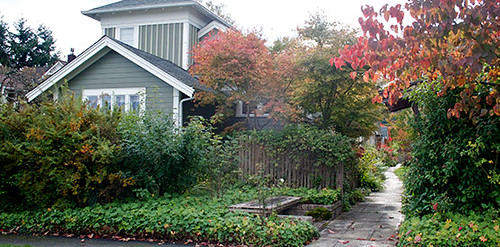 with an ‘open’ side of one house facing the ‘closed’ side of the next. The open side has large windows facing its side yard (which extends to the face of neighboring house), while the closed side has high windows and skylights. (See photo of Third Street Cottages, second from top.) The result is that neighbors do not peer into one another’s world.
with an ‘open’ side of one house facing the ‘closed’ side of the next. The open side has large windows facing its side yard (which extends to the face of neighboring house), while the closed side has high windows and skylights. (See photo of Third Street Cottages, second from top.) The result is that neighbors do not peer into one another’s world.
The website is full of fascinating photos, drawings and models. While the architect has a book and services to market, it becomes clear as one digs in that Chapin is also mission-driven: he believes in this idea and wants to spread it to others. In the "Creating Pocket Neighborhoods" section, for example, there are beautiful photo-examples of some of the core characteristics, sketches and renderings of site-design variants, and even a section on how neighbors might choose to manage their own pocket neighborhood. (Personally, I'm more than a bit wary of neighborhood associations but, if you're so inclined, you might as well have a good model.)
The site shows how pocket neighborhoods can be small or larger, and how they can nest within an existing community. There's even a section on how to create a zoning code to accommodate pocket neighborhoods. That's not a bad idea since, like so much of smart growth, it's likely to be illegal in many communities without a variance. Sigh.
Chapin allows that pocket neighborhoods probably aren’t for everyone, but he believes – as do I – that the market segment to which they appeal is growing. For those who seek a greater sense of community, the concept is definitely one very promising way to go. Here he is on how the shared commons can benefit kids:
“Children need increasingly larger zones of play as they grow up. A baby explores the room their parent occupies, while an older sibling is free to play in the next room, or in the back yard. At some point, though, a child’s desire to explore the world beyond the front gate is blocked by the real and perceived ‘stranger danger’ and traffic. Children are then chauffeured to friends’ houses and organized activities until they can drive on their own. Too often, children feel painfully isolated and lack access to safe, unplanned play.
“Pocket neighborhoods provide a protected, traffic-free environment for a child’s widening horizon — a place for unplanned play alone and with other children, and a place to have relationships with caring adults other than parents. This matches their growing curiosity, need for increased responsibilities and maturing social skills.”
That makes a lot of sense, no? Here’s a video of Ross Chapin showing one of his developments:
Move your cursor over the images for credit information.
Please also visit NRDC’s Sustainable Communities Video Channel.
